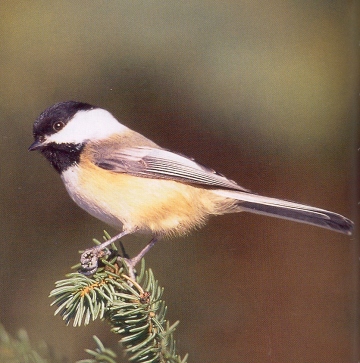|

Medium-sized, stocky chickadee with pale gray upperparts and breast
and pale olive-brown underparts. The black cap and bib and white cheeks
are conspicuous. Black bill is short and thin. Wings are dark with broad
white edges on feathers. State bird of Maine and Massachusetts.
|
BLACK-CAPPED
CHICKADEE
Poecile atricapillus
PASSERIFORMES
Range
and Habitat
Breeds from Alaska to Newfoundland, south to northern California, northern
New Mexico, Missouri, and northern New Jersey; spends winters south
to Maryland. Inhabits deciduous and mixed forests and open woodlands;
often occurs in suburban areas during winter.
SOUND: "chick-a-dee-dee-dee", "fee-bee", "fee-bee-be"
The song of the Black-capped Chickadee is one of the most complex vocalizations
of all animals, acting as a contact call,
an alarm call, to identify an individual, or to indicate
recognition of a particular flock.
They may cache food in hundreds of different sites, recalling those
locations and retrieving food up to 28 days later.
It is the state bird of Maine and Massachusetts.
A group of chickadees are collectively known as a "banditry"
and a "dissimulation" of chickadees.
The Black-capped Chickadee is a small songbird found in deciduous and
mixed woodlands in Canada, Alaska and other northern parts of the United
States. In New Brunswick, New Jersey, this species overlaps with the
Carolina Chickadee. The two are almost identical, except for a difference
in call patterns and pitch. They may also interbreed in this area.
The Black-capped Chickadee may sometimes migrate south
in the winter, but is typically non-migratory. They nest in existing
holes in trees, and will sometimes use old woodpecker
nests for raising their young.

 |
|
|
|